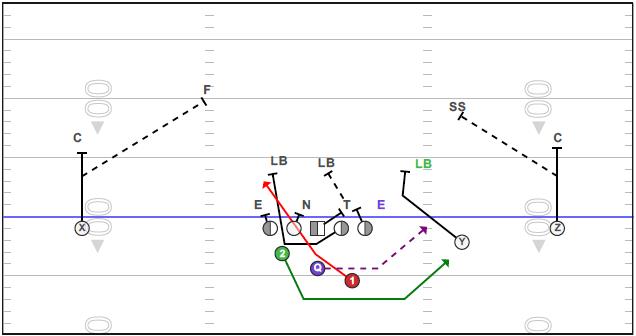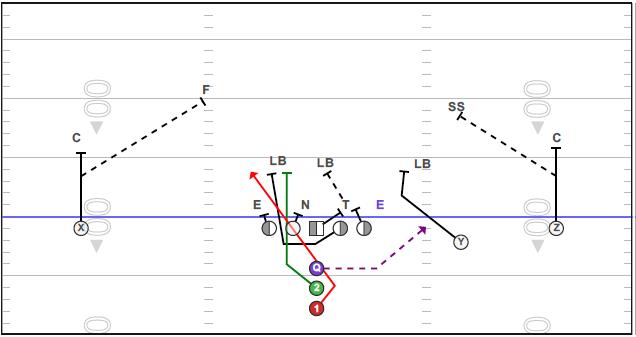Just like any other
Part I - The Origin of the Power Series
II . part - Off Tackle Power is entitled to title
Hold the power series
Although “Power” was defined as a variant of Power O without being caught in the 1980s, most crimes, including West Coast crimes that predominate in the background, still take most of the Power Series games in textbooks, among other names. This involves using multiple defenders to change the flow of the backfield, change the shot lock, lock the head, or send someone else somewhere.
The path to power exploration
18/19 BOB (Big-On-Big, Back-On-Backer) Classic Power Sweep
 |
| 1982 San Francisco 49ers textbook |
 |
| Delaware Wing Testbook since 1975 |
And this will be the main problem as Wing T adapts to modern games.
 |
| Auburn Offensive Textbook 2010 |
As the outside force becomes more basic, the team begins to introduce a version of the standard power "bounce" to focus on blocking shots.
 |
| 1995 Florida Invasion Collection |
While this is probably the standard power and call, the EMOL defense and the standard momentum and depth allow this game to pass.
A source of modern bluffs and counters
The 16/17 bluff is a repetition of this scale of power, when the FB falsifies a follower and the PSG pushes it to act as a downward scheme. But most importantly, it holds the shock unit and the wrap unit.
 |
| 1982 San Francisco 49ers textbook |
It’s similar to the way some groups are down today. Here with BSG instead of central push
Currently we do not want to cover Global Counter OT and Counter OF / OH, but it is almost impossible because:
 |
| 1989 Alabama Offensive Collection |
It is true that they are cousins. In the 1990s, most game books included both, but not in the beginning. Many command options (and the use of field lock for many of these commands have already been introduced) rarely attract OL. But they still include trap blocks as a change. So your strength in fighting this system depends (or not in this case) on the BSG strike bloc and the FB leadership.
 |
| 1968 Houston Hurl Playbook |
Until now, counterattacks were based on the wrong direction in the background, including game simulations. This cousin power has changed the game a lot. The opposite OT, like most counters that day, started in the wrong direction from the back and from the game.
This could be a FB trap and a back attack (or else a return of the wing).
 |
| 1983 Nebraska Offensive Collection |
Or there could be a false back and forth with the FB, a remnant of an era split with a modern configuration of igniting without being captured.
 |
| 1985 UConn Offensive Player |
In the mid-1980s, there was a revolution in zoning and teams like the Joe Gibbs Washington football team. It allows the FB and 12 people to seal the back with their wings.
 |
| 1992 Washington Redskins Playbook |
And when it was difficult to lock the back, the opposite appeared, using the same two shoes and collecting games as power, but changing his responsibilities.
 |
| 1994 Penn State Offensive Playbook |
Power away
Another thing that area / option commands use is breaking blocks as an internal change in the basic model. This has changed the strength of the A-gap in many textbooks.
90/91 O is a form of power gap, so OL splits the defense and goes to ESR MIKE.
 |
| 1982 San Francisco 49ers textbook |
At the time, it also appeared in the book Nebraska Choices
 |
| 1983 Nebraska Offensive Collection |
He gained new life when North Dakota began actively using A-gap power
Bread with butter in NDSU - the power of emptiness. Check the discipline of the left guard so that he can stand up during his turn. pic.twitter.com/bUgGtqOhHx
- Brad Kelly (@ BradKelly17) January 11, 2020
Good LG / LT 😳 My God pic.twitter.com/xlwdLPt6kW
- Ben Fennell (@benfenel_nfl) January 19, 2021
Technician deal6
TE’s head back has given Power a lot of trouble in the past. To shoot too tight, it’s not far enough to get a good combination inside the board and drive on the board. The key to playing with Arc TE TE Stress often affects the natural spread of technique 6, such as playing a sharp pass or defending a range block.
14/15 HB O is a variant of Y-Arc Power O, which has become a natural way to block a defender with the help of 6 technologies. Arc blocks typically extend the player to impact and allow TE to deal with grease.
 |
| 1997 Buffalo Bill: An Offensive Book |
 |
| 1982 San Francisco 49ers textbook |
16/17 BIM (seen above, but this time with Y-arc) C-Gap Defender has PST and FB off-Y-arc and PSLB, with a possible double command to avoid the extractor.
 |
| 1982 San Francisco 49ers textbook |
Fraud support
Lag OA Gap is a form, the only back force with a split flow at the back, is an early form of darts. In the 80’s and 90’s the teams basically supported different types of split streams so that the defenders wouldn’t immediately see the direction of the chef’s career.
 |
| 1983 San Francisco 49ers offensive book |
 |
| 1998 Wisconsin Book |
The only force behind it
While the answer may seem obvious now, with all the Power Solid and Split Flow versions you’ve seen above, the initial expansion commands were difficult to determine how to capture power in their frame. Some went straight to the modern answer.  |
| 1998 Washington Husky Offensive Textbook |
 |
| Oklahoma 1999 Offensive Collection |
With the possibility of forcing the 3rd and 8th FG efforts. Someone has to play a game.
- Rest # (@ JDue51) October 20, 2019
QB Bai. pic.twitter.com/q7rjxLiycR
Darts were another favorite of the time
 |
| Northwest 2000 Offensive Collection |
Mizzou throws darts at the double front 4i
- Coach Dan Casey (@CoachDanCasey) on July 21, 2018
- The top of H drops the defender
- Stuck in LT4i
- LG and C double nose, up as desired
- RG lock on back 4i
- RT finished the microphone
QB RPO holds back defender from false pic.twitter.com/vBzVnvt4g7
 |
| Kansas Offensive Text 2002 |
 |
| 2004 New England Patriots Offensive Tutorial |
 |
| Ohio State Textbook for 2014 |
 |
| Ohio State Offensive Textbook 2014 |
 |
| 1992 attacker textbook |
Race for Mile Jackson's 22P part TD. A well-crafted block by Marcus Allen at the front.
- Old Football Movie (ilFilmHistoric) April 16, 2021
LOl_TimeFootball
pic.twitter.com/REDJeUs7qS
Locks have been added to the game using multiple TE or WR moves
 |
| San Francisco Offensive Text 2014 |
I wrote two articles about Wisconsin using exactly that ( link 1 , link 2 ).
In a more modern sense, this led to the Q-Run game, which used RB as an additional blocker.
 |
| 2014 San Francisco 49ers Offensive Book |
Teams have also learned to use WR or TE to take advantage of the power lock on the balls.
 |
| Utah 2004 Textbook |
 |
| 2007 AFCA "The Power Game" |
 |
| Ohio State Textbook for 2014 |
 |
| Ohio State Offensive Textbook 2014 |
 |
| Pennsylvania Crime 2019 |
Penn State Darts ’repeat with McSorley & Barkley was terrifying. Both can make big yards pic.twitter.com/pumIZpXz4b
- Tony Schiffman (@coachshiffman) January 4, 2019
 |
| More in US football |
 |
| Follow the video link |










No comments:
Post a Comment
Note: only a member of this blog may post a comment.